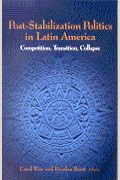Studies in this week’s Hutchins Roundup find that forecast targeting is the best policy rule for the Fed to follow, older Americans would work longer if job hours were more flexible, and more.
Want to receive the Hutchins Roundup as an email? Sign up here to get it in your inbox every Thursday.
Forecast targeting is the most effective way for the Fed to fulfill its mandates and to be held accountable
Critics of the Federal Reserve believe that it is not accountable enough to the public and have suggested that the Fed should use well-specified rules rather than having full discretion when making monetary policy decisions. Lars Svensson of the Stockholm School of Economics argues that the best policy rule for the Fed is to follow “forecast targeting”—selecting a policy rate and future path that leads to forecasted inflation around the 2 percent target and forecasted employment around its maximum level. He notes that such a rule is better than a rigid Taylor-type rule that adjusts monetary policy based on current inflation and unemployment because it also accounts for other factors that help predict future inflation and employment. In addition, forecast targeting would enhance the credibility of the forecasts and the Fed’s effectiveness because it would require publishing the policy-rate path, the forecasts of inflation and employment, and justifications of the decisions, says Svensson.
Older Americans would work longer if job hours were more flexible
Using survey data on Vanguard Group account holders, John Ameriks of the Vanguard Group and co-authors examine older Americans’ willingness to work. Survey respondents were asked to accept or reject hypothetical job offers with different characteristics, such as schedule flexibility, occupation type, and wage. The authors find that participants, even those who are long retired, have a strong willingness to work, especially in jobs with flexible schedules, and that they are willing to trade lower wages for preferred work schedules. Older Americans’ labor force participation appears to be constrained more by a lack of acceptable job opportunities than by an unwillingness to work longer, the authors conclude, suggesting that employers must not find it profitable to employ older workers on a part-time basis.
Trade openness increases income per capita and has no effect on inequality in the long run
Countries more open to international trade have higher living standards and lower income inequality, but it is unclear whether this relationship is causal. Using data from 1990-2015, Diego Cerdeiro and Andras Komaromi of the IMF exploit the variation in countries’ geographic characteristics to try to answer this question. Because geographic characteristics predict a country’s trade openness but are unlikely to directly affect living standards or inequality, geographic variables (like being landlocked, distance to trading partners) can help identify the causal impacts of trade. The authors find that more trade openness leads to higher real income per capita. Specifically, a 1 percentage point increase in trade openness increases real income per capita by between 2 and 5 percent. They find no evidence that trade increases inequality. However, the authors note that their findings reflect the long-run effects of trade and do not account for temporary adjustment costs that could result from changes in a country’s openness to trade over time.
Chart of the week: Job-finding rate continues to increase, job-loss rate declines

Quote of the week:
“Obviously, there is inherent uncertainty about the outlook for the economy. And so the committee’s expectations about appropriate policy evolve over time in line with the outlook. When that happens, my experience is that market participants feel that often that they have been misled… I would say that market participants certainly should have understood…that these are not Odyssean type of promises, but Delphic type of forward guidance at best,” says Fed chair Janet Yellen.
“We’re always trying to emphasize the economic conditionality of our forthcoming policy decisions…And for the broader public, as opposed to market participants, I think the most important thing is to know what is it that we’re trying to achieve, and that we intend to readjust our instruments–that, after all, most members of the public are not fixated on what’s going to happen at the next meeting, or will there be two or four increases, but they do want to know that we’re committed to our 2 percent inflation objective, that we want to achieve our employment mandate, and that we will readjust these instruments as we think necessary in light of those policy goals. That’s our commitment. But I do think that market participants are looking for greater certainty about the policy path than central bankers think it’s appropriate to offer most of the time.”
The Brookings Institution is committed to quality, independence, and impact.
We are supported by a diverse array of funders. In line with our values and policies, each Brookings publication represents the sole views of its author(s).










Commentary
Hutchins Roundup: Forecast targeting, labor force participation of older Americans, and more
November 16, 2017